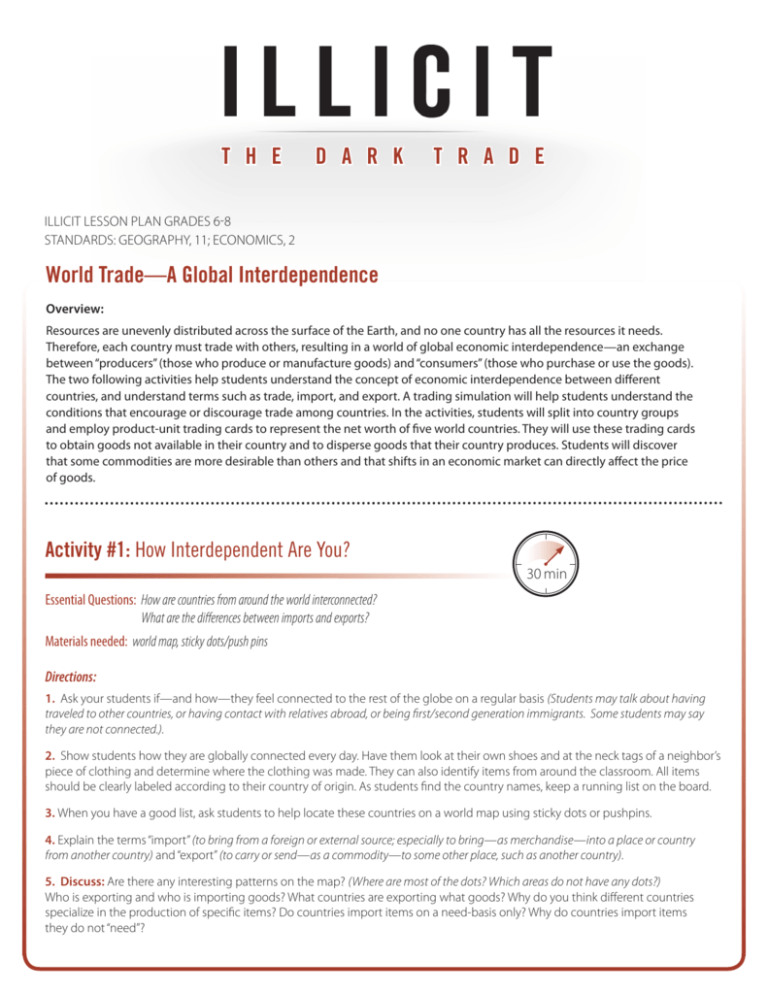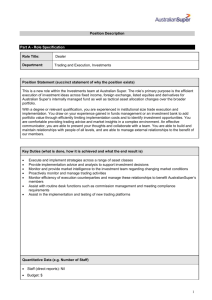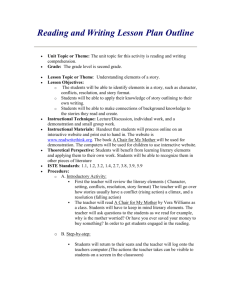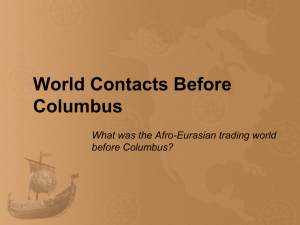World Trade—A Global Interdependence
advertisement

T H E D A R K T R A D E ILLICIT LESSON PLAN GRADES 6-8 STANDARDS: GEOGRAPHY, 11; ECONOMICS, 2 World Trade—A Global Interdependence Overview: Resources are unevenly distributed across the surface of the Earth, and no one country has all the resources it needs. Therefore, each country must trade with others, resulting in a world of global economic interdependence—an exchange between “producers” (those who produce or manufacture goods) and “consumers” (those who purchase or use the goods). The two following activities help students understand the concept of economic interdependence between different countries, and understand terms such as trade, import, and export. A trading simulation will help students understand the conditions that encourage or discourage trade among countries. In the activities, students will split into country groups and employ product-unit trading cards to represent the net worth of five world countries. They will use these trading cards to obtain goods not available in their country and to disperse goods that their country produces. Students will discover that some commodities are more desirable than others and that shifts in an economic market can directly affect the price of goods. Activity #1: How Interdependent Are You? 30 min Essential Questions: How are countries from around the world interconnected? What are the differences between imports and exports? Materials needed: world map, sticky dots/push pins Directions: 1. Ask your students if—and how—they feel connected to the rest of the globe on a regular basis (Students may talk about having traveled to other countries, or having contact with relatives abroad, or being first/second generation immigrants. Some students may say they are not connected.). 2. Show students how they are globally connected every day. Have them look at their own shoes and at the neck tags of a neighbor’s piece of clothing and determine where the clothing was made. They can also identify items from around the classroom. All items should be clearly labeled according to their country of origin. As students find the country names, keep a running list on the board. 3. When you have a good list, ask students to help locate these countries on a world map using sticky dots or pushpins. 4. Explain the terms “import” (to bring from a foreign or external source; especially to bring—as merchandise—into a place or country from another country) and “export” (to carry or send—as a commodity—to some other place, such as another country). 5. Discuss: Are there any interesting patterns on the map? (Where are most of the dots? Which areas do not have any dots?) Who is exporting and who is importing goods? What countries are exporting what goods? Why do you think different countries specialize in the production of specific items? Do countries import items on a need-basis only? Why do countries import items they do not “need”? Activity #2: The Trading Game 30 min Essential Questions: What are the key characteristics of international trade? How does international trade affect a country’s economy? Materials needed: approximately five copies of trading card template - cut out individual cards Directions: 1. Divide the class into five groups and assign each group one of the following countries: United Kingdom, China, Colombia, Saudi Arabia, and Ghana. 2. List the following exports on the board: Gold, Oil, Lumber, Electronics, Coffee 3. Tell students that they will participate in a hypothetical trading game and provide each group with a random set of approximately ten trading cards each (see “Trading Card Template” attachment). 4. Go over the objectives of the game—Each student should aim to get the most points by trading their country’s goods for products from another country. Each team will start with a set of trading cards that represents their country’s worth. The game allows for “free trade,” meaning any country (group) can trade with another and any item and/or amount of product can be traded for another. Students may have to creatively market their product(s) and/or combine products (cards) to end up with something more desirable. 5. Assign the following values to each product. Write this information on the board for reference during trading. a. Gold – five points per unit b. Oil – four points per unit c. Lumber – three points per unit d. Electronics – two points per unit e. Coffee – one point per unit 6. Allow for ten minutes of open trading. 7. After approximately ten minutes of trading, announce the following: WORLD SITUATION: The world is running out of oil, making oil extremely rare and much more expensive. OUTCOME: The worth of oil increases by two points (NOTE: Teacher to make this change to the point system on the board). 8. Allow for two additional minutes to trade. 9. Announce that trading time is over and have groups tally points. 10. Offer the following world situation and outcome to see how it impacts the final results: WORLD SITUATION: Ghana learns to make counterfeit electronics, making their electronics cheaper. OUTCOME: Ghana takes one electronic unit from each country. 11. Re-tally the points. 12. Discuss the following questions: Did any countries end the game richer or poorer than they started? What was it like to be a rich country? A poor country? Was it easy or difficult to trade? Why? Did any countries feel especially powerful or powerless? Which items were most popular? Which were least popular? Why? Content Development: Nancee Hunter, Writer; Alice Manning, NG Education & Children’s Programs, Editor; Chelsea Zillmer, Fact checker; Katie Wilson, U.S. Chambers, Reviewer; Kim Hulse, NG Education & Children’s Programs, Reviewer. Design: Patrick Truby. Project Management: Jeff Dow, NG Television & Film; Melissa Goslin, NG Education & Children’s Programs. T H E D A R K T R A D E THREE UNITS OF GOLD TWO UNITS OF COFFEE ONE UNIT OF ELECTRONICS ONE UNIT OF OIL TWO UNITS OF COFFEE THREE UNITS OF ELECTRONICS THREE UNITS OF LUMBER TWO UNITS OF LUMBER ONE UNIT OF OIL THREE UNITS OF COFFEE TWO UNITS OF OIL ONE UNIT OF ELECTRONICS We hope that you found the educational materials for National Geographic’s Illicit: The Dark Trade to be valuable. To better understand your needs for future materials, we would like to hear your opinions. Your responses are of great help to us. Thanks! How would you rate the educational materials for Illicit: The Dark Trade? Excellent Good Fair Poor Did not use How many other educators have you shared the Illicit: The Dark Trade materials with? None 1-5 6-10 10+ How much time would you estimate you spent using the materials with your students? 1 to 2 hours 2 to 3 hours 4 to 5 hours > 4 hours Not Very Not at all Did not use How likely are you to use the materials again? Very Somewhat These materials were developed as companion to the TV show National Geographic’s Illicit: The Dark Trade. How interested are you in educational materials that are produced as companions to other National Geographic TV shows and movies? Very Somewhat Not Very Not at all Have these materials increased your awareness of counterfeiting and its reach? Yes No Does the National Geographic brand affect your likelihood to use the materials? I am more likely to use materials from National Geographic The National Geographic brand has no impact on my likelihood to use I am less likely to use materials from National Geographic How likely are you to visit the US Chamber of Commerce website (www.thetruecosts.org) for more information about protecting yourself from counterfeit goods? Very Somewhat Not Very Not at all What could National Geographic do to improve these types of materials in the future? Yes! I’d like to know about future National Geographic programs. Email address: Zip Code: Thank You Please return this survey to National Geographic or by Fax: 202.775.6178 By Mail: Jeff Dow Attn: Jeff Dow National Geographic 1145 17th Street NW Washington, DC 20036







